三年级英汉笔译(一)学生用书
- 格式:doc
- 大小:415.50 KB
- 文档页数:73
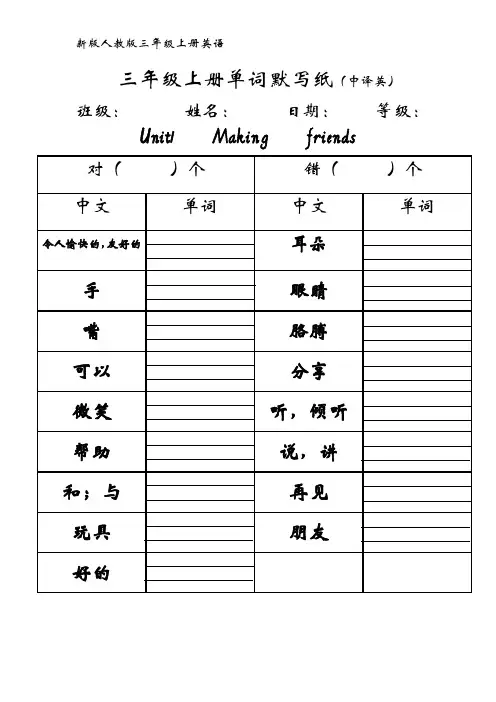
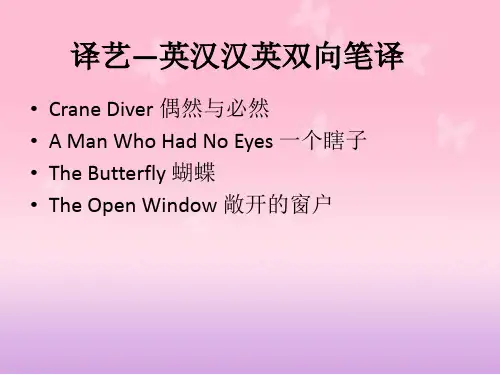
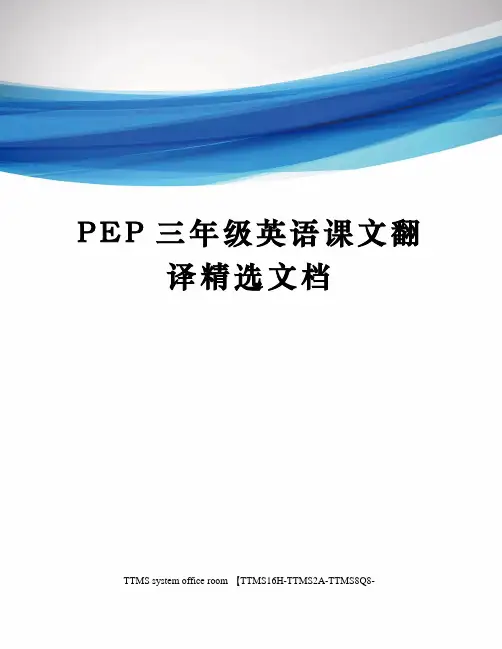
P E P三年级英语课文翻译精选文档TTMS system office room 【TTMS16H-TTMS2A-TTMS8Q8-1unit1教材第2页课文翻译Zoom:Welcome!祖姆:欢迎!Zip:Welcome!次波:欢迎!John:Wu Yifan,this is Amy.约翰:吴一凡,这是埃米。
Wu Yifan:Hi! Nice to meet you.吴一凡,:嗨!很高兴见到你。
Where are you from?你来自哪里?Amy:l'm from the UK.埃米:我来自英国。
2unit1教材第3页课文翻译Miss White:Welcome back!Nice to see you again.Nice to see you again.怀特老师:欢迎回来!很高兴再次见到你们。
Sarah and Chen Jie:Nice to see you,too.萨拉和陈杰:(我们)也很高兴见到您。
人教版三年级下册英语unit1教材A部分课文翻译1let's talk部分翻译Miss White:Boys and girls,we have two new friends today.怀特:孩子们,今天我们有两位新朋友。
Amy:Hi,l'm Amy.l'm from the UK.埃米:嗨,我是埃米。
我来自英国。
Zhang Peng:Hi,l'm ZhangPeng. l'm from Shandong. 张鹏:嗨,我是张鹏。
我来自山东。
John and Sarah:Welcome!约翰和萨拉:欢迎!2Look and say部分翻译Mike:Hi,l'm Mike.l'm from Canada.What about you? 迈克:嗨,我是迈克。
我来自加拿大。
你呢?Sarah:Hi,l'm Sarah.l'm from the USA.萨拉:嗨,我是萨拉。
![三级笔译综合课文--英汉翻译练习[5篇模版]](https://uimg.taocdn.com/44250e3ca9114431b90d6c85ec3a87c240288a01.webp)
三级笔译综合课文--英汉翻译练习[5篇模版]第一篇:三级笔译综合课文--英汉翻译练习三级笔译综合-课文翻译练习7 班级:学号:姓名:电影导演虽然以虚荣自负、独断专行、唯我独尊而著称,但是,由于导演这项艺术工作的特殊性,使得他们隐身幕后。
大多数情况下,导演自身强烈的个性特征需要通过他人的面部表情和肢体语言才能表现出来。
比如,提起导演约翰·福特,在你脑海中出现的也许是演员约翰·韦恩的形象。
导演伊利亚·卡赞富有激情,不易相处,行事专断,其个性不亚于同辈中的任何人,他的形象将主要通过一批演员塑造的艺术形象而留在人们的记忆中。
卡赞先生星期天去世了,随后的电视讣告就像是一部精选的专辑,汇聚了众多体验派演艺明星。
在这里,有演过《欲望号街车》和《码头风云》马龙·白兰度,他高喊“斯特拉!”,他悄悄地对罗德·斯泰格尔说,他本来有可能是一个有力的竞争对手;有演过《伊甸园之东》的詹姆斯·狄恩,有演过《天涯何处无芳草》的华伦·比提。
英俊的年轻人,动人地演绎了一段痛苦的情感;有《娃娃新娘》里的埃里·瓦拉赫和卡尔·莫尔登,两人倾情演绎了密西西比蛇舞,其妖艳性感以及票房收入方面均难以与之抗衡。
作为一个“演员工作室”的建立者,卡赞先生在20世纪40年代后期经常穿梭于百老汇和好莱坞之间。
他把美国戏剧写实主义所表现的细腻情感及其演艺风格带到了美国电影里,也许这方面卡赞先生居功至伟。
早期电影里程式化的语言表达和优雅的动作被取代了,首创了一种吞吞吐吐、含含蓄蓄的情感演艺方式。
社会问题、委婉表达的性以及心理真实等问题成了舞台和荧屏上严肃剧的标志。
现实主义,任何艺术形式中的现实主义,都是一个带有明显欺骗性的术语。
尤其是在电影艺术中,幻想着透明地反映现实,这种幻想最为严重。
如今看来,卡赞先生的电影,反映的似乎不像生活片段,更像社会的寓言,心理的寓言,与其说质朴粗狂,还不如说夸张高调。
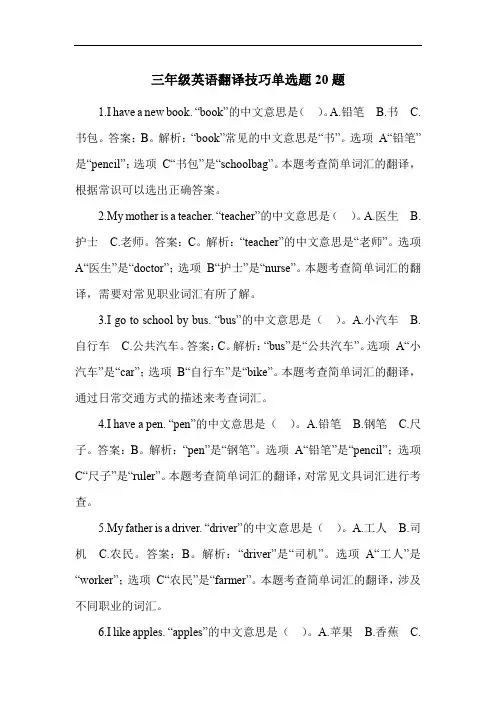
三年级英语翻译技巧单选题20题1.I have a new book. “book”的中文意思是()。
A.铅笔 B.书 C.书包。
答案:B。
解析:“book”常见的中文意思是“书”。
选项A“铅笔”是“pencil”;选项C“书包”是“schoolbag”。
本题考查简单词汇的翻译,根据常识可以选出正确答案。
2.My mother is a teacher. “teacher”的中文意思是()。
A.医生 B.护士 C.老师。
答案:C。
解析:“teacher”的中文意思是“老师”。
选项A“医生”是“doctor”;选项B“护士”是“nurse”。
本题考查简单词汇的翻译,需要对常见职业词汇有所了解。
3.I go to school by bus. “bus”的中文意思是 )。
A.小汽车 B.自行车 C.公共汽车。
答案:C。
解析:“bus”是“公共汽车”。
选项A“小汽车”是“car”;选项B“自行车”是“bike”。
本题考查简单词汇的翻译,通过日常交通方式的描述来考查词汇。
4.I have a pen. “pen”的中文意思是 )。
A.铅笔 B.钢笔 C.尺子。
答案:B。
解析:“pen”是“钢笔”。
选项A“铅笔”是“pencil”;选项C“尺子”是“ruler”。
本题考查简单词汇的翻译,对常见文具词汇进行考查。
5.My father is a driver. “driver”的中文意思是()。
A.工人 B.司机 C.农民。
答案:B。
解析:“driver”是“司机”。
选项A“工人”是“worker”;选项C“农民”是“farmer”。
本题考查简单词汇的翻译,涉及不同职业的词汇。
6.I like apples. “apples”的中文意思是()。
A.苹果 B.香蕉 C.橘子。
答案:A。
解析:“apples”是“苹果”的复数形式。
选项B“香蕉”是“bananas”;选项C“橘子”是“oranges”。
本题考查简单词汇的翻译和名词复数形式的识别。
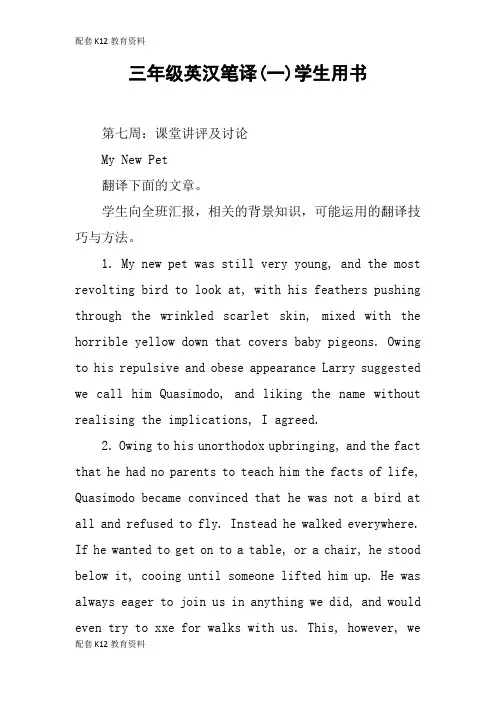
三年级英汉笔译(一)学生用书第七周:课堂讲评及讨论My New Pet翻译下面的文章。
学生向全班汇报,相关的背景知识,可能运用的翻译技巧与方法。
1. My new pet was still very young, and the most revolting bird to look at, with his feathers pushing through the wrinkled scarlet skin, mixed with the horrible yellow down that covers baby pigeons. Owing to his repulsive and obese appearance Larry suggested we call him Quasimodo, and liking the name without realising the implications, I agreed.2. Owing to his unorthodox upbringing, and the fact that he had no parents to teach him the facts of life, Quasimodo became convinced that he was not a bird at all and refused to fly. Instead he walked everywhere. If he wanted to get on to a table, or a chair, he stood below it, cooing until someone lifted him up. He was always eager to join us in anything we did, and would even try to xxe for walks with us. This, however, wehad to stop, for either you carried him on your shoulder, which was risking an accident to your clothes, or else you let him walk behind. Then you had to slow down your pace to suit his for should you get too far ahead you would hear the most frantic and imploring coos and turn round to find Quasimodo running desperately after you, indignant at your cruelty.3. Quasimodo insisted on sleeping in the house: nothing could get him to sleep in the pigeon-loft I had made for him. He preferred to sleep on the end of Margo ‘s bed. Eventually, however, he was banished to the drawing-room, for if Margo turned over in the night Quasimodo would wake, hobble up the bed and perch on her face, cooing loudly and lovingly.4. It was Larry who discovered that Quasimodo wasa musical pigeon. Not onlydid he like music, but he actually seemed to recognise two different varieties, the waltz and the military march. For ordinary music he would get as close to the gramophone as possible and sit there with eyes half-closed, purring softly. But if the music was a waltz he would move round and round the machine, bowing,twisting and cooing. For a march--Sousa for preference, he inflated his chest and stamped up and down the room, while his coo became so rich that he seemed in danger of strangling himself.5. One sad day we found that he had duped us, for there, among the cushions, lay a46glossy white egg. He never quite recovered from this. He became bitter and sullen and started to pick irritably if you tried to pick him up. Then he laid another and his nature changed xxpletely. He, or rather she, began to treat us as if we were her worst enemies. Not even the gramophone would tempt her back in the house. The last time I saw her she was sitting in an olive tree, cooing while a large, very masculine-looking pigeon twisted and cooed at her in a perfect ecstasy of admiration(488 words)1.讨论:有哪些背景知识会对翻译带来影响?有没有释义或加注的必要?为什么?文中一系列生动活泼的动词如何翻译?文中轻快幽默的风格如何体现?―他‖,―她‖,―它‖字如何使用?为什么?472.阅读下面的材料并进行练习:注意颜色词的翻译A. redred letter day:红色还指―负债‖或―亏损‖,因为人们总是用红笔登记负数。
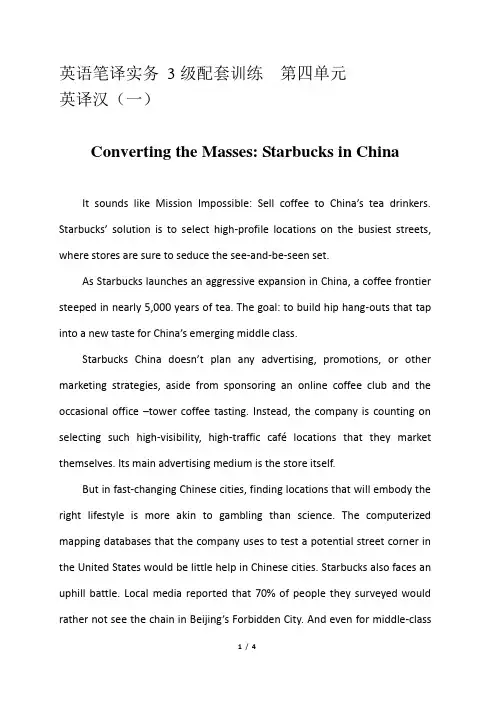
英语笔译实务3级配套训练第四单元英译汉(一)Converting the Masses: Starbucks in ChinaIt sounds like Mission Impossible: Sell coffee to China’s tea drinkers. Starbucks’ solution is to select high-profile locations on the busiest streets, where stores are sure to seduce the see-and-be-seen set.As Starbucks launches an aggressive expansion in China, a coffee frontier steeped in nearly 5,000 years of tea. The goal: to build hip hang-outs that tap into a new taste for China’s emerging middle class.Starbucks China doesn’t plan any advertising, promotions, or other marketing strategies, aside from sponsoring an online coffee club and the occasional office –tower coffee tasting. Instead, the company is counting on selecting such high-visibility, high-traffic café locations that they market themselves. Its main advertising medium is the store itself.But in fast-changing Chinese cities, finding locations that will embody the right lifestyle is more akin to gambling than science. The computerized mapping databases that the company uses to test a potential street corner in the United States would be little help in Chinese cities. Starbucks also faces an uphill battle. Local media reported that 70% of people they surveyed would rather not see the chain in Beijing’sForbidden City. And even for middle-class Chinese, Starbucks is a barely affordable luxury.While retailers say a top marketing weapon in urban China is to charge more for public consumption. That’s because Chinese customers have different priorities than their American yuppie counterparts. Guys 40 years old are not coffee drinkers, but if the environment is good and the coffee is not bad, they’ll come back. The store layout, artwork and food options make Starbucks more friendly to Chinese eyes, but coffee remains the cor e offering and people don’t go there for the coffee. They go there to present themselves as modern Chinese in a public setting.课文词汇Starbucks 星巴克咖啡店akin 性质相近的;相似的yuppie 雅皮士参考译文星巴克强力吸引中国消费者向中国的饮茶人兜售咖啡,听起来像是不可能完成的任务(天方夜谭)。
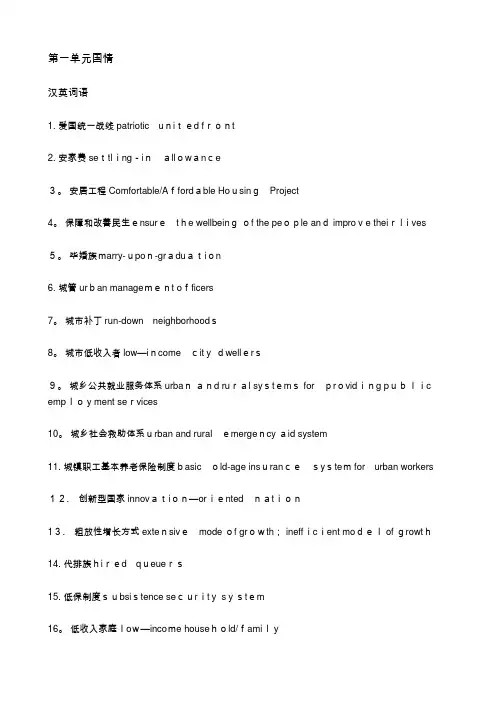
第一单元国情汉英词语1. 爱国统一战线patriotic united front2. 安家费settling-inallowance3。
安居工程Comfortable/Affordable HousingProject4。
保障和改善民生ensurethe wellbeingof the people and improve their lives5。
毕婚族marry-upon-graduation6. 城管urban management officers7。
城市补丁run-down neighborhoods8。
城市低收入者low—incomecitydwellers9。
城乡公共就业服务体系urbanand rural systems forproviding public employment services10。
城乡社会救助体系urban and ruralemergency aid system11. 城镇职工基本养老保险制度basicold-age insurancesystem for urban workers12.创新型国家innovation—orientednation13.粗放性增长方式extensivemode of growth; inefficient model of growth14. 代排族hired queuers15. 低保制度subsistence security system16。
低收入家庭low—income household/family17. 地方保护主义regional protectionism18. 短租房short-term housing/ accommodation19。
恶搞videospoof20。
恶性循环vicious circle21.二手房pre-owned house; second-hand house22。
法治政府law-based government23. 房奴mortgage slave24。
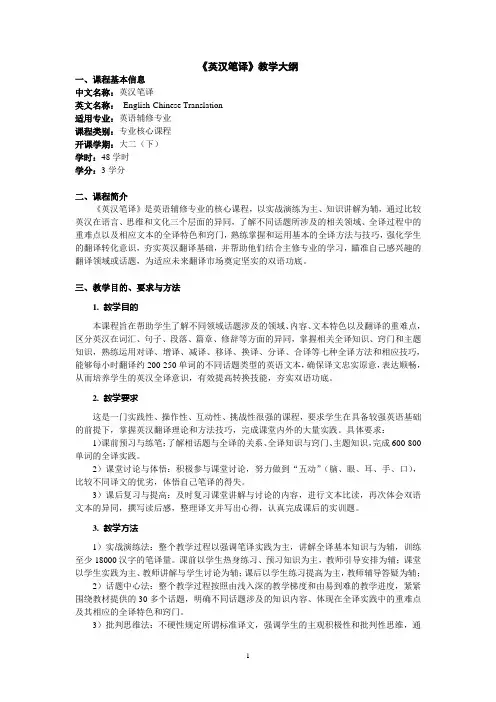
《英汉笔译》教学大纲一、课程基本信息中文名称:英汉笔译英文名称:English-Chinese Translation适用专业:英语辅修专业课程类别:专业核心课程开课学期:大二(下)学时:48学时学分:3学分二、课程简介《英汉笔译》是英语辅修专业的核心课程,以实战演练为主、知识讲解为辅,通过比较英汉在语言、思维和文化三个层面的异同,了解不同话题所涉及的相关领域、全译过程中的重难点以及相应文本的全译特色和窍门,熟练掌握和运用基本的全译方法与技巧,强化学生的翻译转化意识,夯实英汉翻译基础,并帮助他们结合主修专业的学习,瞄准自己感兴趣的翻译领域或话题,为适应未来翻译市场奠定坚实的双语功底。
三、教学目的、要求与方法1. 教学目的本课程旨在帮助学生了解不同领域话题涉及的领域、内容、文本特色以及翻译的重难点,区分英汉在词汇、句子、段落、篇章、修辞等方面的异同,掌握相关全译知识、窍门和主题知识,熟练运用对译、增译、减译、移译、换译、分译、合译等七种全译方法和相应技巧,能够每小时翻译约200-250单词的不同话题类型的英语文本,确保译文忠实原意,表达顺畅,从而培养学生的英汉全译意识,有效提高转换技能,夯实双语功底。
2. 教学要求这是一门实践性、操作性、互动性、挑战性很强的课程,要求学生在具备较强英语基础的前提下,掌握英汉翻译理论和方法技巧,完成课堂内外的大量实践。
具体要求:1)课前预习与练笔:了解相话题与全译的关系、全译知识与窍门、主题知识,完成600-800单词的全译实践。
2)课堂讨论与体悟:积极参与课堂讨论,努力做到“五动”(脑、眼、耳、手、口),比较不同译文的优劣,体悟自己笔译的得失。
3)课后复习与提高:及时复习课堂讲解与讨论的内容,进行文本比读,再次体会双语文本的异同,撰写读后感,整理译文并写出心得,认真完成课后的实训题。
3. 教学方法1)实战演练法:整个教学过程以强调笔译实践为主,讲解全译基本知识与为辅,训练至少18000汉字的笔译量。
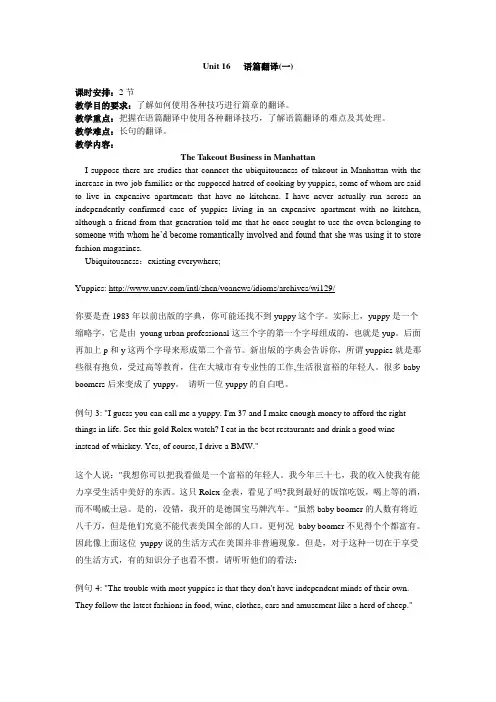
Unit 16 语篇翻译(一)课时安排:2节教学目的要求:了解如何使用各种技巧进行篇章的翻译。
教学重点:把握在语篇翻译中使用各种翻译技巧,了解语篇翻译的难点及其处理。
教学难点:长句的翻译。
教学内容:The T akeout Business in ManhattanI suppose there are studies that connect the ubiquitousness of takeout in Manhattan with the increase in two-job families or the supposed hatred of cooking by yuppies, some of whom are said to live in expensive apartments that have no kitchens. I have never actually run across an independently confirmed case of yuppies living in an expensive apartment with no kitchen, although a friend from that generation told me that he once sought to use the oven belonging to someone with whom he’d become romantically involved and found that she was using it to store fashion magazines.Ubiquitousness:existing everywhere;Yuppies: /intl/zhcn/voanews/idioms/archives/wi129/你要是查1983年以前出版的字典,你可能还找不到yuppy这个字。

三年级英汉笔译(一)学生用书北京外国语大学英语学院英汉笔译实践课教材(一级) 2021级学生用书2010年9月-2011年1月目录开篇课程综述?? 课程介绍 ?? 课程大纲 ?? 考核方式 ?? 附:阅读书目单元一关于翻译?? 什么是翻译? ?? 翻译的目的、标准、要求 ?? 翻译技巧与方法综述与练习 ?? 案例分析:如何做翻译---评析Nobel Prize Acceptance Speech 的翻译单元二翻译技巧针对性练习?? 增词、减词的练习:1. Father?s Toe2. Henry David Thoreau?? 加注与释义的练习:3.Long Bow Village 4.Mao's Childhood 5.My New Pet?? 拆译---长句翻译练习: 6.I Have a Dream7.President Nixon's Toast?? 转换练习:8.Portrait of A President9.Amending U.S. Constitution单元三综合技巧语篇练习?? 商务10.A Letter to Vice Premier Li Lanqing?? 科技11.Cyberphobics 12.Water2?? 新闻13.Up on the New Farm 14.X-Sports?? 散文、述评、文件15. The Special Joys of Super-Slow Reading 16.The Age of Rock Revisited 17.The British Museum?? 附录---自主学习平台练习课外练习 The Price of Peace3开篇课程综述4笔译实践课介绍 (三年级第一学期)1.课程名称: 笔译(英译汉)实践---一级笔译2.课程简介:本课程为大学英语专业三年级第一学期的翻译实践课。
课程以每周一次的课堂练习和隔周一次的课后练习及讲评相结合,旨在系统向学生介绍翻译的定义、标准、技巧,并进行针对性的训练,同时在各种体裁和题材的翻译实践中强化技巧。
北京外国语大学英语学院 英汉笔译实践课教材(一级)学生用书2008年9月-2009年1月目 录开篇 课程综述课程介绍 课程大纲 考核方式 附:阅读书目单元一 关于翻译什么是翻译? 翻译的目的、标准、要求 翻译技巧与方法综述与练习 案例分析:如何做翻译---评析Nobel Prize Acceptance Speech 的翻译单元二 翻译技巧针对性练习增词、减词的练习:1. Father‟s Toe2。
Henry David Thoreau加注与释义的练习:3.Long Bow Village 4.Mao's Childhood 5.My New Pet拆译---长句翻译练习: 6.I Have a Dream7.President Nixon's Toast转换练习:8.Portrait of A President9.Amending U.S. Constitution单元三 综合技巧语篇练习商务10.A Letter to Vice Premier Li Lanqing科技11.Cyberphobics 12.Water 新闻13.Up on the New Farm14.X-Sports散文、述评、文件15. The Special Joys of Super-Slow Reading 16.The Age of Rock Revisited 17.The British Museum附录---申雨平自主学习平台练习 课外练习 The Price of Peace开篇课程综述笔译实践课介绍(三年级第一学期)1.课程名称: 笔译(英译汉)实践---初级笔译2.课程简介:本课程为大学英语专业三年级第一学期的翻译实践课。
课程以每周一次的课堂练习和隔周一次的课后练习及讲评相结合,旨在系统向学生介绍翻译的定义、标准、技巧,并进行针对性的训练,同时在各种体裁和题材的翻译实践中强化技巧。
学习完本课程的水平大致相当于全国外语翻译证书考试三级(初级)笔译的水平。
本课程实用教材为任课教师自行编撰的油印教材以及申雨平、戴宁编撰的《实用英汉翻译教程》。
3.课程目标:参加完本课程的学习,学生将能够:●在规定时间内进行翻译,速度为每小时300-350字(原文)●完成课后作业、讨论、汇报、小论文及测验●综述本课程中讨论的10个翻译的技巧与2个翻译方法,并能在练习中使用相关技巧与方法●完成一般科技、旅游、商务、经贸、新闻、散文等方面材料的翻译,同时体现各种体裁所需要的不同翻译技巧●在翻译时体现出忠实、通顺、流畅的标准,同时进一步提高双语翻译技巧,对两种文化的差异保持敏感性●逐步建立分析批评能力,对笔译工作进行评价●为翻译和相关学术领域进行进一步研究做好准备*4。
国家大纲对大学本科英语专业三、四年级翻译实践课的要求⏹根据《高等学校英语专业英语教学大纲》中对翻译的要求:三年级(六级)四年级(八级)要达到:⏹了解翻译基础理论和英、汉两种语言的异同⏹掌握常用翻译技巧⏹将中等难度的英语篇章或段落翻译成汉语⏹将英美报刊上的文章以及文学原著翻译成汉语⏹译文忠实原文、语言通顺、流畅⏹速度为每小时翻译250~300个英文单词⏹能担任外宾日常生活和一般外事活动的口译5.本课程的要求⏹要求达到国家大纲的上限,每小时翻译300~350英文单词⏹对学生的作业从英语水平、汉语水平、知识面、工作态度等方面提出要求◆理解准确,不应出现重大的理解错误◆表达忠实、通顺、流畅,语言比较地道,语法正确,标点符号正确,搭配合理,结构工整,不鼓励编译、自由翻译◆知识面宽,能够依靠上下文和知识面推测出意义◆工作态度严谨,勤查字典,减少错字、别字,交作业前至少间隔一天,至少有一次校对的过程◆逐步展开专业翻译训练,培养解决问题的能力◆逐步明确技巧型翻译与技能型翻译的差别,向技能型翻译发展6. 练习安排:1)课堂练习:油印教材的篇子,间或配合《实用英汉翻译教程》中的语篇。
2)课后练习:油印教材中的篇子,对此进行深入、仔细的翻译实践和讲评。
3)油印教材最后有附录,收录了学生自主学习的内容。
7.对书面作业的要求:一般都要打印。
应注明:To:From:Subject: (e.g.) Father‘s ToeDate: September 24, 20068.教师评改作业可以使用的编辑符号awk. (表达、用词、行文等)别扭adding(?) 增译?/增意?comp. 理解错误collocation 搭配错误expr. 表达错误w. wording 用词不当punc. 标点符号错误str. 句子结构meaning 意思不明确/准确cap. 大小写错误gram. 语法错误spelling 别字logic 逻辑错误dic. 用字/词不当pron.介词用法不当,主要是指第三人称衔接的滥用和误用。
*每个教师可以用自己的符号,只要事先和学生说明一下即可。
9. 考核评估:总评分按100分记课堂练习、发言、测验25%课后练习、论文、汇报13%期中考试20%期末考试40%出勤2%*每次无故缺席,总分将被扣除2-3分。
10.上课方式:教师讲授、小组讨论、学生汇报、评估与反馈讨论:对翻译实践课(初级笔译)的期望(在学期末进行对照):目前我(学生)对翻译的了解:我对翻译实践课的期望:我对目录中、课程介绍中所列内容的评价、问题:A Course Syllabus for E-C Translation Practice(Year III)Course Name: English-Chinese Translation Practice for Year ThreeCourse Description:This is a full course for one year. This syllabus is for the autumn semester.This course is designed for the 3rd year college students to acquire basic skills in translation through weekly translation practice and feedback so as to empower them with basic and intermediate qualification in translation practice.Course Objectives:After one year‘s course, 3rd year students should be able to:●translate with or without the aid of dictionaries in a given time at a speed of300-350 words (source text) per hour●summarize 10 translation skills and 2 translation methods●translate texts of technology, travel and tourism, business, economy, newsreport, simple literature works, etc. respecting different features of styles andapplying genre sensitivity into translation practice●finish assigned tasks, short papers, presentations●identify and apply basic translation skills through practice●nurture a deep and sensitive bicultural skills●develop analytical and critical skills required to evaluate work in translation●prepare for further study in translation and relation academic fieldCourse Assessment:In-class exercises, discussions, quizzes, 25%Take-home assignments, presentations, short papers 13%Middle-term exam 20%Final exam 40%Class attendance 2%*For each absence without grounded excuse(s), 2-3 points will be deducted from thetotal score.Aspects to Give Feedback on Translation Practice:●Competence in source language (E)●Competence in target language (C)●Scope of knowledge●Working ethics and conscientiousnessTeaching Methods:●Provide in-class exercise---→feedback--→take-home assignment---→in-class feedback●Help group discussion●Organize peer evaluation and feedback单元一关于翻译第一周:讲座与讨论1.什么是翻译?⏹翻译的定义很多,根据不同目的的翻译活动,界定也不尽相同。
⏹字典定义:◆to translate is to turn from one language into another (The Oxford English Dictionary):从一种语言转换成另一种语言;◆to translate is to turn into one‘s own language or another language (Webster‘s Third NewInternational Dictionary of the English Language):转换成本族语或另一种语言)⏹本课程大致认为:翻译是把一种语言的信息用另一种语言表达出来,使译文读者能得到原作者所表达的思想,得到与原文读者大致相同的感受。